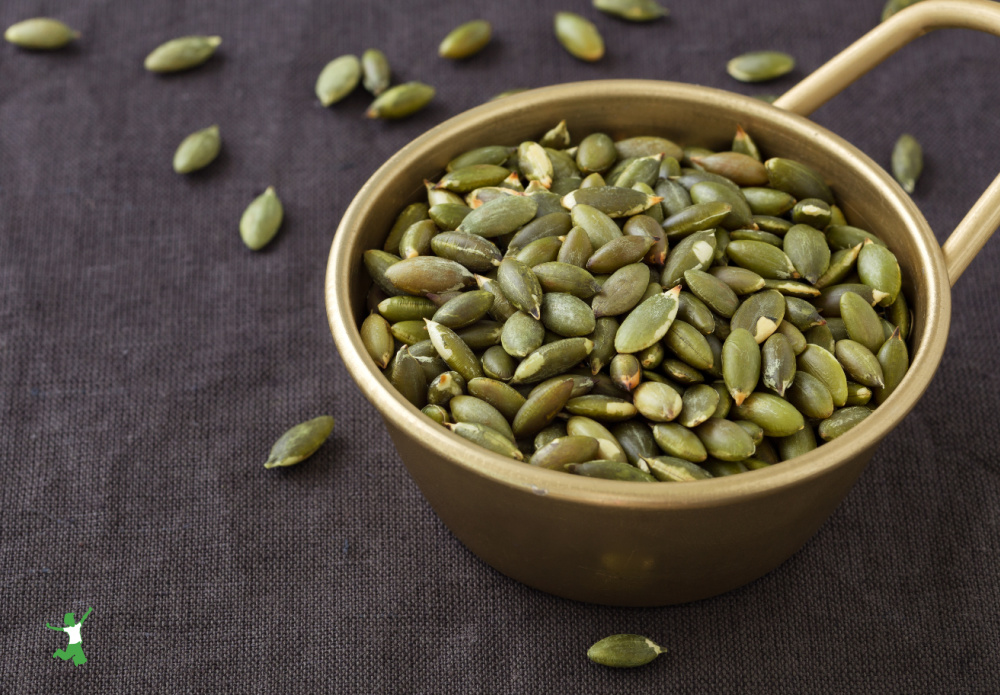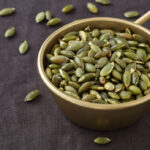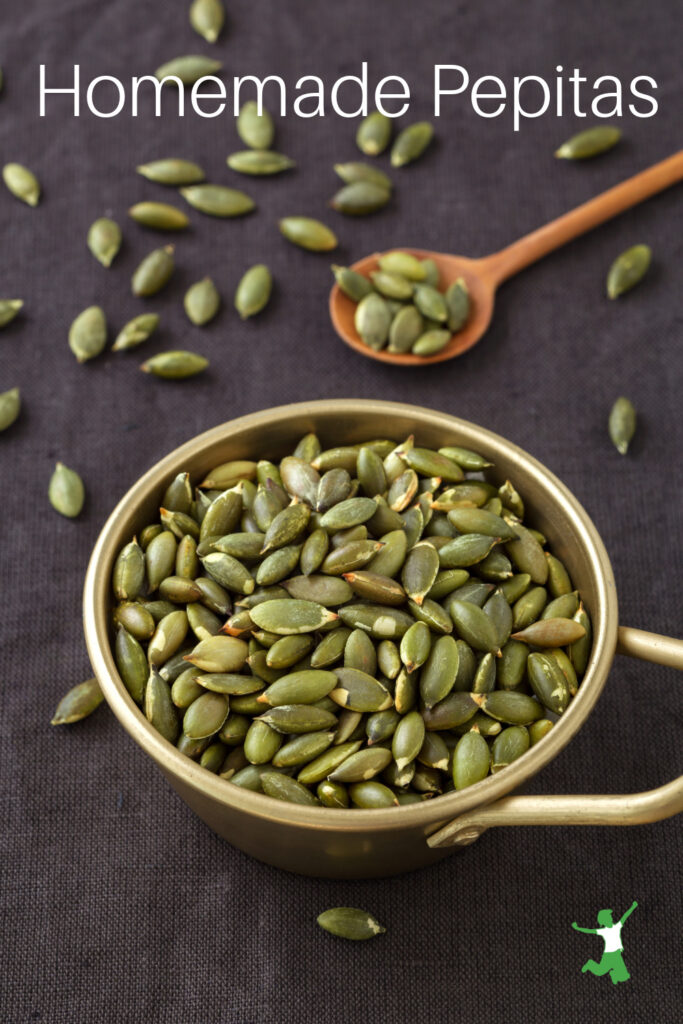Table of Contents[Hide][Show]
How to make pepitas, an excellent grain-free substitute for croutons on salads. A delightful crunch with no carbs! Great for snacks as well.

My favorite way to add crunchiness to a salad with no carbs is to sprinkle on homemade pepitas.
Pepitas are slightly tangy, crispy, hulled pumpkin seeds that have been soaked in filtered water with sea salt and a bit of cayenne pepper.
They are then dried to crispy perfection in a warm (no higher than 150°F/ 65 °C) oven to preserve rawness.
As described in Nourishing Traditions Cookbook, seeds were one of the staple foods in the diet of the Aztec culture.
Preparation involved soaking the seeds in brine water and then drying them out in the sun.
The pepitas were consumed whole or ground into meal for baking after the drying process was complete.
Seeds should always be soaked and then dried before consuming.
This important preparation step neutralizes the anti-nutrients such as phytic acid in the hulls of the seeds, which interfere with digestion and absorption of nutrients.
Soaking nuts is a similar process.
Once again, traditional cultures show us that proper preparation of the nutrient-dense foods is as important as the food itself.
Fresh Pumpkin Seeds?
If you are wondering about the white seeds inside a fresh pumpkin….
These are unhulled pumpkin seeds as compared with green pumpkin seeds, which have had the hulls removed.
Feel free to soak and dry white pumpkin seeds as described in the linked article and enjoy with the hulls on!
Tip: The hull of pumpkin seeds is known to have anti-parasitic effects on the gut.
If you don’t wish to eat unhulled seeds due to sensitivity to fiber, you can hull them by hand before soaking and still preserve the rawness using either method below.
Or, just buy them already hulled to save time. This is the brand I suggest.
Manual Method
Pinch individual seeds between your fingers or use a knife to carefully split the outer shell and remove the inner seed. This is time-consuming but precise.
Rolling Pin Method
Place dried seeds in a plastic bag, gently roll with a rolling pin to crack shells, then separate the kernels by hand or with a slotted spoon.
Don’t Have Time to Soak Seeds?
Feel free to use sprouted pumpkin seeds instead of taking the time to soak them if desired.
This brand of sprouted pumpkin seeds is excellent and what I use in a pinch.
Hint: Soaked seeds give a better crunch than sprouted seeds on salads!
To learn more, this article details the health benefits of soaking vs sprouting.

Homemade Pepitas
How to make pepitas, an excellent grain-free substitute for croutons on salads. A delightful crunch with no carbs! Great for snacks as well.
Ingredients
- 4 cups pumpkin seeds raw, hulled
- filtered water enough to cover
- 2 Tbsp sea salt
- 1 tsp cayenne pepper optional
Instructions
-
In a large glass bowl, stir salt into the filtered water and add hulled pumpkin seeds and cayenne. Leave uncovered on the kitchen counter for at least 7 hours or overnight.
-
Drain in a colander and spread wet seeds on cookie sheets. Dry in a warm oven (no more than 150 °F/ 65°C) for about 6-8 hours or until completely dry. A food dehydrator with stainless steel trays works great too.
-
Pepitas keep well in an airtight container in the pantry – even in warm, humid climates like where I live in Florida.









Any suggestions for drying the seeds if your oven won't go below 170 degrees? Shorter time, etc,?
Bonnie
Hi Jenna, I get them at Nutrition S'Mart in airtight bags.
Hi Sarah,
Do you order online or is this a grocery store in your area?
Hi, Sarah! Where do you get your hulled seeds? I'm supposed to purchase them in airtight packaging & not from bulk bins, correct? What about butternut & acorn squash seeds (hulls still on)?!? Can I use these somehow Рwe have plenty here from making squash pur̩es for the kiddos.
Excellent post (love the salad idea) thank you!!!
Jenna
I am very hopeful that the WAPF will have a review of this book is in an upcoming Wise Traditions Journal. Before I potentially waste my time reading any health books these days (there are soooo many), I usually wait to see if they are even worth reading by checking out if they get a thumbs up or thumbs down from the Foundation.
Sarah,
What do you know about the advertisement about the Hugh Downs Report? The book looks interesting, but can it be trusted?
Yes! Dehydrators can be used to dry the pepitas also. Check the user manual on your oven, though. More recent models have the ability to adjust by 20F degrees or so the lowest heating limit.
I noticed this recipe in the Nourishing Traditions cookbook and would love to try it. Because my oven does not apparently go below 170, would this also work in my dehydrator which does? I love nuts and seeds in my salads.
Susie
Hi Sarah, I love pumpkin seeds and my husband and I put them on our salads and also steel cut oatmeal in the morning. I know they have lots of benefits for your health. The recipe you posted for them sound yummy and I will try it out. I noticed all the titles of your posts and will be checking them out as I have a great interest in nutrition and health. (I have read and researched for 20 years due to my youngest son's health, that God healed after 17 years by using food, specifically beans.) Thank you for the interesting blog. 😀
Hi Lisa,
All seed foods with the exception of flax seeds are high in antinutrients such as phytic acid. Flax seeds do not require soaking for this reason. Is soaking sesame seeds is a challenge due to their small size, try sprouting them which achieves the same purpose as soaking. If you keep them wet and rinse 3-4 times per day, the tiny sprouts should appear in 2-3 days.
Sarah, I have used seeds on my salads for years! I am wondering about sesame seeds. I buy my sesame seeds with the hulls still on. Is there any special way of soaking and drying such a small seed?